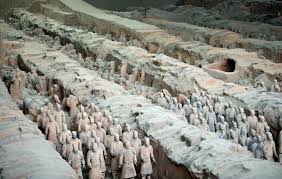
Beyond the Warriors: Hidden Treasures of the Terracotta Army
The Terracotta Army, standing guard over the tomb of China's First Emperor, Qin Shi Huang, is a sight to behold. Yet, the army of warriors is only the tip of the archaeological iceberg. The vast burial complex, discovered in 1974, holds within its earthen embrace a treasure trove of artifacts that shed light on the opulence and intricate beliefs of the Qin Dynasty.
Horses and Chariots: Symbols of Power and Prestige
Alongside the infantry, ranks of terracotta horses stand frozen in time, ready to pull ornate bronze chariots into the afterlife. These horses, meticulously crafted with lifelike detail, were considered essential for the emperor's journey and military prowess in the next world. The chariots, some discovered disassembled, were status symbols of the highest order, reflecting the emperor's wealth and authority.
Bronze Ritual Vessels: Echoes of Ancient Ceremonies
Scattered throughout the pits, archaeologists unearthed a collection of bronze vessels, each a testament to the craftsmanship of the Qin artisans. These vessels, intricately decorated with mythical creatures and geometric patterns, were used in elaborate rituals and ceremonies. Their presence suggests the importance of maintaining cosmic balance and appeasing the gods, even in death.
Jade Jewelry and Ornaments: Markers of Status and Spirituality
Beyond the grandeur of horses and chariots, the tomb revealed a more intimate side of the Qin Dynasty – a fascination with intricate jade carvings. Delicate ornaments, beads, and pendants, meticulously carved from precious jade, were found adorning the bodies of some warriors and scattered throughout the pits. Jade, believed to possess spiritual and protective qualities, was highly prized in ancient China, and its presence speaks to the high status of those buried within the complex.
Gold and Silver Treasures: Glimpses of Imperial Wealth
While less common than bronze or jade, traces of gold and silver were also unearthed in the tomb complex. Fragments of gold and silver ornaments, likely adorning clothing or weapons, hint at the lavish lifestyle enjoyed by the emperor and his court. The use of such precious metals further emphasizes the importance of showcasing wealth and status even in the afterlife.
Sima Qian's Account: A Historian's Perspective
The discovery of these treasures echoes the writings of the Han Dynasty historian, Sima Qian. He wrote that Qin Shi Huang, obsessed with preserving his power and wealth even in death, ensured his tomb was filled with "all the treasure that was in the tomb." Driven by paranoia, the emperor, according to Sima Qian, ordered the tomb sealed, fearing his artisans might reveal the secrets of his extravagant burial place.
Q&A
Q: Why were horses and chariots buried with the Terracotta Army? A: Horses and chariots were crucial for both warfare and symbolic journeys in the afterlife. Their inclusion highlights the emperor's military might and his desire for continued power after death.
Q: What is the significance of jade in ancient Chinese culture? A: Jade was highly valued for its beauty and believed to possess spiritual and protective qualities. Its presence in the tomb reflects the high status of those buried there and their belief in the afterlife.
Q: What does the discovery of these treasures tell us about the Qin Dynasty? A: The variety and richness of the artifacts reveal a dynasty obsessed with displaying power, wealth, and a belief in elaborate burial rituals to ensure a prosperous afterlife.